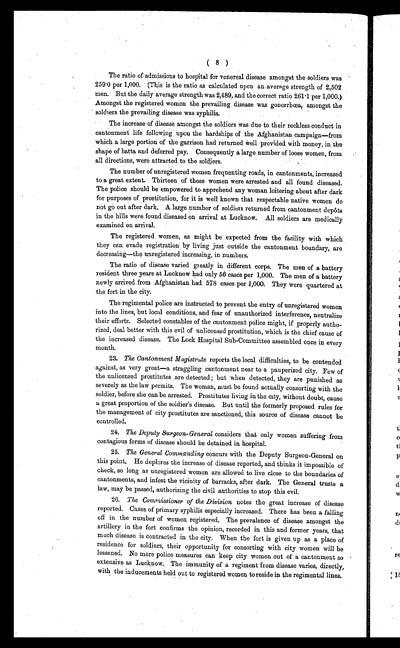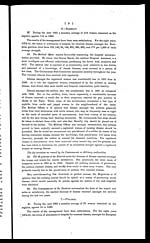Medicine - Institutions > Lock hospitals > Annual report on the working of the lock hospitals in the North-Western Provinces and Oudh > Eighth annual report of the working of the lock hospitals in the North-Western Provinces and Oudh, for the year 1881
(278) Page 8
Download files
Individual page:
Thumbnail gallery: Grid view | List view

( 8 )
The ratio off admissions to hospital for venereal disease amongst the soldiers was
259.0 per 1,000. (This is the ratio as calculated upon an average strength of 2,502
men. But the daily average strength was 2,489, and the correct ratio 261.1 per 1,000.)
Amongst the registered women the prevailing disease was gonorrbœa,amongst the
soldiers the prevailing disease was syphilis.
The increase of disease amongst the soldiers was due to their reckless conduct in
cantonment life following upon the hardships of the Afghanistan campaign—from
which a large portion of the garrison had returned well provided with money, in the
shape of batta and deferred pay. Consequently a large number of loose women, from
all directions, were attracted to the soldiers.
The number of unregistered women frequenting roads, in cantonments, increased
to a great extent. Thirteen of these women were arrested and all found diseased.
The police should be empowered to apprehend any woman loitering about after dark
for purposes of prostitution, for it is well known that respectable native women do
not go out after dark. A large number of soldiers returned from cantonment depôts
in the hills were found diseased on arrival at Lucknow. All soldiers are medically
examined on arrival.
The registered women, as might be expected from the facility with which
they can evade registration by living just outside the cantonment boundary, are
decreasing—the unregistered increasing, in numbers.
The ratio of disease varied greatly in different corps. The men of a battery
resident three years at Lucknow had only 56 cases per 1,000. The men of a battery
newly arrived from Afghanistan had 578 cases per 1,000. They were quartered at
the fort in the city.
The regimental police are instructed to prevent the entry of unregistered women
into the lines, but local conditions, and fear of unauthorized interference, neutralize
their efforts. Selected constables of the cantonment police might, if properly autho-
rized, deal better with this evil of unlicensed prostitution, which is the chief cause of
the increased disease. The Lock Hospital Sub-Committee assembled once in every
month.
23. The Cantonment Magistrate reports the local difficulties, to be contended
against, as very great—a straggling cantonment near to a pauperized city. Few of
the unlicensed prostitutes are detected; but when detected, they are punished as
severely as the law permits. The woman, must be found actually consorting with the
soldier, before she can be arrested. Prostitutes living in the city, without doubt, cause
a great proportion of the soldier's disease. But until the formerly proposed rules for
the management of city prostitutes are sanctioned, this source of disease cannot be
controlled.
24. The Deputy Surgeon-General considers that only women suffering from
contagious forms of disease Should be detained in hospital.
25. The General Commanding concurs with the Deputy Surgeon-General on
this point. He deplores the increase of disease reported, and thinks it impossible of
check, so long as unregistered women are allowed to live close to the boundaries of
cantonments, and infest the vicinity of barracks, after dark. The General trusts a
law, may be passed, authorizing the civil authorities to stop this evil.
26. The Commissioner of the Division notes the great increase of disease
reported, Cases of primary syphilis especially increased. There has been a falling
off in the number of women registered. The prevalence of disease amongst the
artillery in the fort confirms the opinion, recorded in this and former years, that
much disease is contracted in the city. When the fort is given up as a place of
residence for soldiers, their opportunity for consorting with city women will be
lessened. No mere police measures can keep city women out of a cantonment so
extensive as Lucknow. The immunity of a regiment from disease varies, directly,
with the inducements held out to registered women to reside in the regimental lines.
Set display mode to: Large image | Zoom image | Transcription
Images and transcriptions on this page, including medium image downloads, may be used under the Creative Commons Attribution 4.0 International Licence unless otherwise stated. ![]()
| Permanent URL | https://digital.nls.uk/75111705 |
|---|




